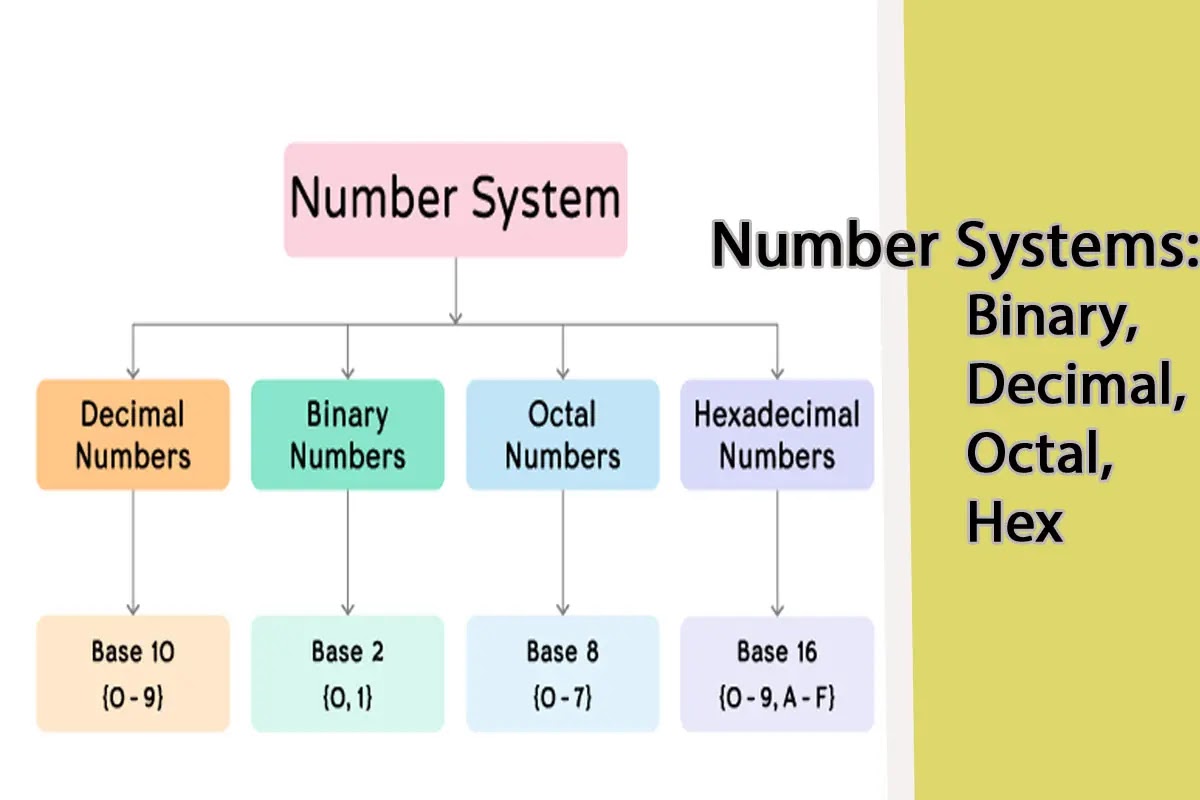In the world of computing and digital electronics, number systems are crucial for representing data, performing calculations, and facilitating communication between systems. These systems are based on specific numerical notations that computers use to process and store data efficiently.
In this blog post, we'll explore the most commonly used number systems in computing: Binary, Decimal, Octal, and Hexadecimal. Understanding these systems is essential for anyone involved in computer science, programming, or electronics.
What Are Number Systems?
A number system is a writing system for expressing numbers in a consistent manner using digits or other symbols. In computing, these systems are used to represent and manipulate data. The most commonly used number systems in computing include:
- Binary (Base-2)
- Decimal (Base-10)
- Octal (Base-8)
- Hexadecimal (Base-16)
Each of these number systems has a specific base, which determines the number of unique digits used in that system.
1. Binary Number System (Base-2)
The binary number system is the foundation of all modern computing. It uses only two digits: 0 and 1. These digits represent low (0) and high (1) states, also known as false and true in logical terms. Binary numbers are the language computers speak because they work with electrical signals, which are either on (1) or off (0).
-
Example: The binary number
1011represents the decimal number11.
Why Binary?
Binary is ideal for computers because it aligns with their internal circuits, which rely on two states (on/off, true/false, high/low). It also makes it easier to design digital circuits that can process data efficiently.
- Binary to Decimal Conversion Example:
-
Binary number:
1010 - To convert to decimal, we multiply each bit by its corresponding power of 2:
- 1 × 2^3 = 8
- 0 × 2^2 = 0
- 1 × 2^1 = 2
- 0 × 2^0 = 0
- Total = 8 + 0 + 2 + 0 = 10 (decimal)
2. Decimal Number System (Base-10)
The decimal number system is the standard system we use in everyday life. It is base-10, meaning it uses ten digits: 0, 1, 2, 3, 4, 5, 6, 7, 8, 9. Decimal is the most familiar number system for humans because it's based on the number of fingers we have (10).
Why Decimal?
Humans naturally use the decimal system because it is intuitive. However, computers do not use decimal directly, and this is why conversion between binary and decimal is necessary.
-
Example: The decimal number
45is simply written as45in base-10.
3. Octal Number System (Base-8)
The octal number system uses eight digits: 0, 1, 2, 3, 4, 5, 6, 7. It is often used as a shorthand for binary numbers because it groups binary digits into sets of three, making it easier to read and write long binary numbers.
-
Example: The octal number
17represents the decimal number15.
Why Octal?
While octal is not as commonly used today as binary or hexadecimal, it was historically used in early computer systems to represent binary data more compactly.
- Octal to Binary Conversion Example:
-
Octal number:
17 -
To convert to binary, we convert each digit to a 3-bit binary equivalent:
-
1 =
001 -
7 =
111
-
1 =
-
Binary =
001 111, or111(in binary)
4. Hexadecimal Number System (Base-16)
The hexadecimal number system is base-16, meaning it uses sixteen digits: 0, 1, 2, 3, 4, 5, 6, 7, 8, 9, A, B, C, D, E, F. The digits A-F represent the decimal values 10-15. Hexadecimal is commonly used in programming and computer science to represent binary data in a more compact and human-readable form.
-
Example: The hexadecimal number
A3represents the decimal number163.
Why Hexadecimal?
Hexadecimal is used in computing because it is much more compact than binary while still being easy to convert back and forth. Each hexadecimal digit corresponds to exactly four binary digits (bits), making it ideal for representing large binary numbers efficiently.
- Hexadecimal to Binary Conversion Example:
-
Hexadecimal number:
A3 -
Convert each hexadecimal digit to its 4-bit binary equivalent:
-
A =
1010 -
3 =
0011
-
A =
-
Binary =
10100011
Conversions Between Number Systems
Understanding how to convert between different number systems is a key skill in computing and digital electronics. Here's a quick overview of how to convert between the common number systems:
Binary to Decimal:
- Multiply each binary digit by its corresponding power of 2 and sum the results.
Decimal to Binary:
- Divide the decimal number by 2, noting the remainder for each step. The binary number is the remainder read from bottom to top.
Binary to Hexadecimal:
- Group the binary digits into sets of four, starting from the right. Convert each group to its hexadecimal equivalent.
Hexadecimal to Binary:
- Convert each hexadecimal digit into a 4-bit binary equivalent.
Applications of Number Systems in Computing
- Data Representation: Binary is the primary language of computers, representing everything from numbers to text (through ASCII encoding) to images and sounds.
- Memory Addressing: Hexadecimal is used in computer programming to represent memory addresses. This makes it easier to work with large binary values in debugging and low-level programming.
- Programming: Many programming languages use hexadecimal to represent colors, memory locations, and data manipulation.
- Digital Circuit Design: Understanding number systems is crucial in digital electronics and circuit design, where binary, octal, and hexadecimal numbers are frequently used to describe logic operations and configurations.
Conclusion
Number systems form the backbone of computing and digital electronics. While we interact with the decimal system daily, computers rely on binary to process and store data. However, hexadecimal and octal offer more compact representations, making them useful for specific computing applications. Understanding how to work with these number systems is vital for anyone interested in programming, computer science, or electronics.


Post a Comment